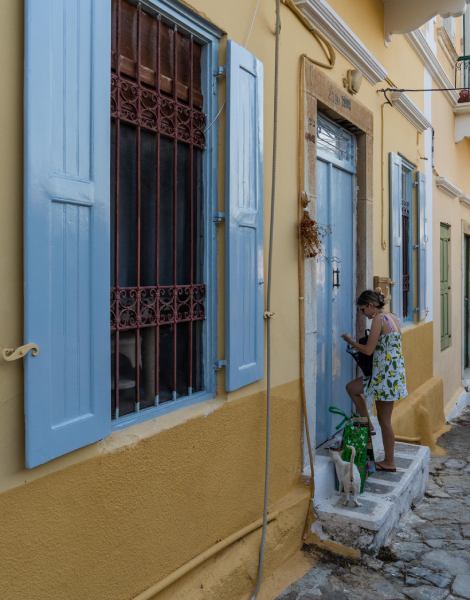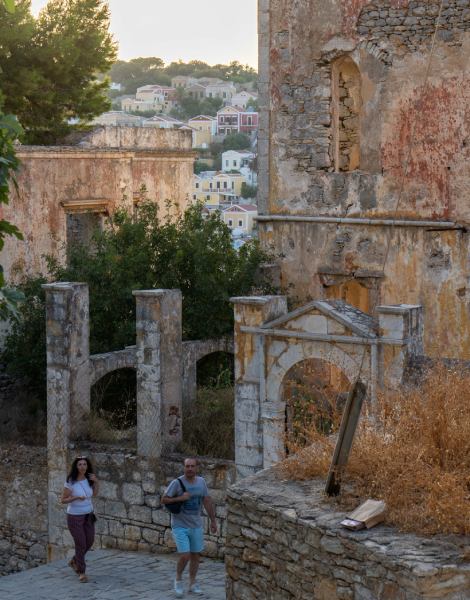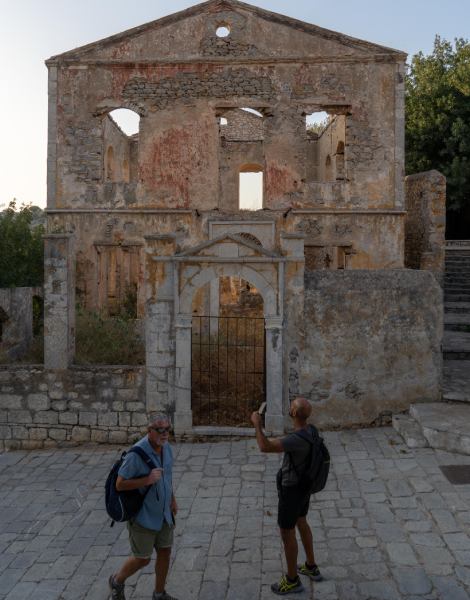Leros: The Underrated Greek Island that Has It...
Discover Leros, a hidden Greek island...

The colorful neoclassical buildings at Yialos.
© Perikles Merakos
by Dimitris Zographos, as told to Eleftheria Alavanou
Can I tell you a story? When I was young, I’d hear my grandmother talking time and again about Symi’s “Big Ben.” It was Big Ben this, Big Ben that. When I first came to Symi, I began chatting with the locals and at some point brought up this Big Ben, but no one had a clue what I was talking about.
It was at that point that I realized that the whole thing was an inside joke, just for my family. It turns out that, in the late 19th century, my antecedents went to England on business, saw Big Ben, and wanted to bring the London landmark back home. And so they donated the clock tower that can be seen to this day in Symi’s main port, Yialos.
Just like many other Symiots, my ancestors were urbanites, well-educated people who traveled a lot and were involved in the sponge trade. According to an “urban legend,” they also trafficked in antiquities.
In truth, it would be reasonable to assume that they did; it’s no longer considered taboo to come out and say something like this openly. After all, when you’re diving into a sea full of underwater antiquities, when you have the equipment to descend to places where no one has ever been before, and when you travel by fishing vessels through completely unregulated waters, you might decide it’s perfectly natural to donate half of your findings to museums, and simply sell the rest.

Dimitris Zographos
© Perikles Merakos

Kali Strata, comprising around 500 steps, connects Yialos with Horio.
© Perikles Merakos

Ochre and "loulaki" bue are two of the colors most commonly seen on Symiot houses.
© Perikles Merakos
Neoclassical architecture was in vogue back in the 19th century, and the buildings on the island are, in part, the product of the commercial trips that Symiots took at that time.
Smyrna, now Izmir, was an important neoclassical city located nearby, one that we often forget about. Photographs of Smyrna before the Catastrophe (the destruction of the city and uprooting of its Greek population in 1922) and the old photographs of Symi show that our island wanted to resemble Smyrna.
Besides that city, Symiots traveled to and brought back architectural ideas from Italy, France and England. They would go to these places aboard boats laden with sponges and return bearing foreign goods. The ceramic roof tiles on Symi’s neoclassical buildings are from Marseilles, and much of the wood used in their construction was sourced in Italy.
Yialos is purely neoclassical. Horio, the settlement above Yialos, is comprised of neoclassical buildings as well as houses that bear the characteristics of Aegean architecture: they’re small-scale, stone-built structures integrated into the landscape.
This is often referred to as “vernacular architecture,” but I personally prefer the term “architecture without architects.”
These are intelligently constructed homes, built to serve the needs of their occupants. Pre-neoclassical dwellings don’t contain the “mistakes” we would later see in neoclassical homes – that is, they aren’t contrived urban structures. Most houses along neoclassical Kali Strata, the 500-step stairway linking Yialos and Horio, were actually built so as to offer people a view of the staircase rather than the natural surroundings.

The "Roloi" clock tower was built in Yialos in 1880.
© Perikles Merakos

A stroll around Horio.
© Perikles Merakos

During the Italian occupation (1912-1943) Symiots lost their fortunes; as a result, many houses that were under construction remained unfinished. The photograph depicts the frame of a neoclassical house, with the characteristic “eye of the ox” seen on the pediment.
© Perikles Merakos
In terms of style, the neoclassical buildings of Symi all share some fundamental characteristics. They feature symmetrical elements, pleasing proportions, exterior shutters, and pediments seemingly supported by whitewashed representations of columns, imitating the style of ancient Greek temples.
The pediments feature a round opening – an “ox eye” – constructed not only for ventilation purposes, but also to ward off evil spirits.
The list of building materials used includes Symiot stone, plaster and mortar; the mortar was made using Santorinian soil in expensive buildings, and mud or sifted terra rossa in the rest. The basic colors used are ocher, terracotta, azure and white, in different combinations.
It is worth noting that neoclassical buildings were much more colorful in the 19th century than they are at present, where ocher predominates.

Inside a Symiot neoclassical house.
© Perikles Merakos

The interior decoration in this neoclassical home goes back to Symi’s prosperous years.
© Perikles Merakos
Neoclassical Symi – as it appears today – was created between 1860 and 1910. It’s amazing that all of this is the result of a mere 50-year period, but things started to go downhill with the arrival of the Italians.
The Symiots – who had learned to work hard and to create – discovered that they had no scope whatsoever for achievement during the period of Italian rule (1912-1943) and, for this reason, began leaving the island.
The local neoclassical architecture was preserved thanks to Kostas Farmakidis, a dentist with a passion for architecture. In 1971, the Municipality of Symi demolished what had been perhaps the most beautiful neoclassical building on the entire island. Outraged at this, Farmakidis moved heaven and earth to get Yialos, Horio and another two settlements – Pedi and Nimborio – proclaimed heritage sites, at a time when the rest of Symi was, as it were, fast asleep.
Dimitris Zographos is an architect of Symiot descent who moved permanently to the island in 2005. He is regularly involved in the restoration of old buildings there.
Discover Leros, a hidden Greek island...
Charming architecture, unique beaches, rich history,...
From Samos to Crete, we've selected...
This short walk takes in eleven...